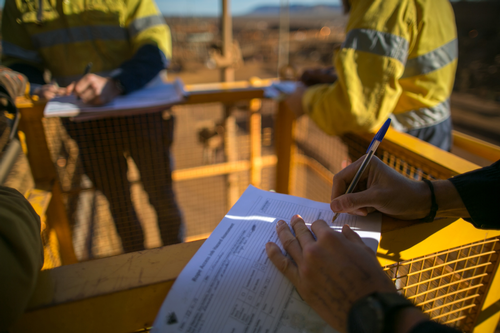MONDAY, MAY 15, 2023
Last week, the Biden-Harris Administration announced a new set of plans to pass as a part of bipartisan permitting reform legislation. The plans arrive almost one year after the White House's Permitting Action Plan was released.
According to the White House, these actions are anticipated to create new union jobs, combat climate change, grow the economy and lower costs. The Administration has outlined a list of recommendations that could help speed up the permitting process, including:
The Biden-Harris Administration also states that necessary permits, reviews and approvals must be robust and completed within a reasonable timeframe. To aid in this process, the administration urges Congress to act and improve coordination of federal data sharing, expand the use of programmatic and tiered reviews and reduce the length of federal decision documents.
Streamlining this process will also reportedly include the enhancement of data collection. The White House notes that the systems used by many agencies today are either outdated or rely on paper systems. To combat this, the White House also reports it is pushing for the development of automated, joint electronic permit application for federal agencies.

 |
| Kings Access / Getty Images |
|
Last week, the Biden-Harris Administration announced a new set of plans to pass as a part of bipartisan permitting reform legislation. |
Additionally, the process for streamlining reportedly includes actions to recruit and retain a permitting workforce and to provide financial benefits for states that are willing to adopt best practices to accelerate the delivery of public and privately funded projects.
The White House Fact Sheet adds that, earlier this month, the Biden-Harris Administration announced the completion of a new Memorandum of Understanding to facilitate the permitting of electric transmission infrastructure. This action will supposedly accelerate the permitting of transmission lines and direct federal agencies to conduct permit decisions and environmental reviews within two years of its beginning.
In addition to speeding up permitting reform, the Administration has outlined the following priorities to be included in the bipartisan permitting reform package:
The plan reportedly involves the construction of both on and offshore sites for the development of electric power while also setting new, updated goals for the construction of renewable energy sites in 2030 and 2035.
Also included in these updated goals are actions to expand and speed up the process of producing critical minerals, while still maintaining environmental safety and consulting people on surrounding tribal land. The White House hopes to set a global standard for responsible development while also creating jobs across the country by permitting managing operations and repairing mines.
The Administration is also encouraging the construction of new, clean energy facilities on formerly contaminated sites. The EPA currently has over 200,000 Brownfield sites with clean energy potential, but are reportedly restricted by potential liabilities. The latest plan would protect developers of clean energy who have made reasonable investments to combat contamination and ensure they do not increase risk to human health and the environment, the White House explains
Last year, in May, the Administration released a new Permitting Action Plan to accelerate federal permitting and environmental reviews for infrastructure projects funded through the bipartisan infrastructure law.
The action plan outlines the strategy to ensure that federal environmental reviews and permitting process are effective, efficient and transparent, while guided by the best available science to promote positive environmental and community outcomes. In turn, it hopes that these steps will help strengthen supply chains, lower costs and grow clean energy.
Additionally, the goal is to deliver long overdue infrastructure investments on task, on time and on budget without delays while promoting environmental goals. The action plan will reportedly result in better permitting outcomes, enhanced predictability for project sponsors and increased accountability.
According to the White House Fact Sheet, the Permitting Action plan is built on five key elements to help ensure timely and effectively delivery of infrastructure upgrades:
As part of the action plan, the Administration says it will leverage the interagency Federal Permitting Improvement Steering Council’s expanded authorities under the bipartisan infrastructure law to improve coordination among agencies, help avoid and resolve potential conflicts and bottlenecks, identify and share best practices, and accelerate information sharing and troubleshooting.
This includes interagency coordination on siting, permitting, supply chain and related issues, as well as promoting efficient and timely reviews. This will be done in part by developing and preparing new approaches to permitting and environmentally review to help address common issues, eliminate duplication and incorporate a climate-smart approach.
The White House also plans to create permitting schedules with clear timeline goals that are both ambitious and realistic, contain relevant milestones and meet all requirements. To increase transparency and accountability, the Federal Permitting Dashboard will also track key project information, including these timelines and milestones.
Accelerating Infrastructure
Then, in October of last year, the Biden-Harris Administration announced a new action plan to accelerate progress of infrastructure construction through the bipartisan infrastructure law. On Oct. 13, the White House hosted a summit for officials to discuss the new actions with an aim to improve coordination between state and local officials who directly account for 90% of the spending.
The action plan focuses on three main areas: delivering projects on time, staying on task and delivering projects on budget. Staying on task will also include equitable access and technical assistance, as well as workforce readiness and permitting.
According to the Administration, key actions include:
The full action plan and its initiatives can be viewed here.
Tagged categories: Construction; Government; Government contracts; Green Infrastructure; Infrastructure; Infrastructure; Program/Project Management